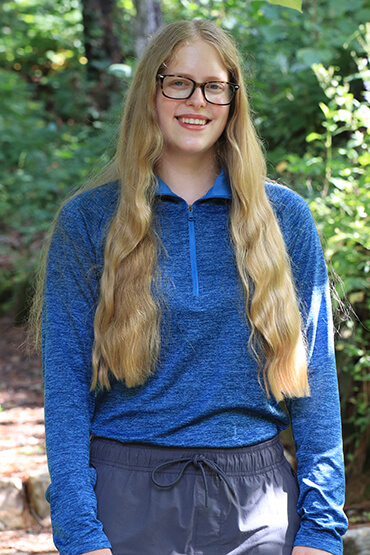Native Plants’ Water Filtration Abilities
A Key to Improving Water Quality
Throughout the world, water pollution is a pressing environmental issue, affecting both natural ecosystems and human health. With this issue in mind, as the 2023 Rotary Club of Shades Valley intern for the Friends of Birmingham Botanical Gardens, I’ve decided to investigate the water filtration capabilities of native Alabama plant species compared to non-native species.
By conducting visual and chemical filtration experiments with impatiens, zinnias (non-native), blue flag iris (Iris virginica), and river oats (Chasmanthium latifolium) (native), I sought to determine whether native plants outperformed non-native species in filtering out various pollutants commonly found in creek and tap water.
The results showed that native plants, particularly river oats, were more efficient at removing visual and chemical pollutants, making them a promising solution for enhancing water quality.
BY Maria Timberlake, 2023 Rotary Club of Shades Valley intern
Introduction:
Water pollution poses a significant threat to ecosystems and public health. The use of native plants for water filtration has garnered increasing interest due to their healthy root systems. In this study, I examined the water-filtering capabilities of native Alabama species, specifically blue flag iris and river oats, in comparison to non-native species such as impatiens and zinnias. I hypothesized that the native species would perform better overall since native plants are usually better established.
Materials and Methods:
•Visual Filtration Experiment:
For the visual filtration experiment, I prepared multiple trials of “contaminated” water by adding blue dye, laundry soap, sediment, and red dye to mimic real-life pollutants. I poured this water through each plant’s root system, catching the filtered water for analysis. View PowerPoint.
•Chemical Filtration Experiment:
In the chemical filtration experiment, I tested tap water and creek water. I analyzed the water samples for pH, hardness, free chlorine, iron, copper, lead, fluoride, MPS, chlorine, cyanuric acid, bromine, ammonia chloride, nitrate, nitrite, and carbonate before and after passing through the plants’ root systems.
Results:
The results of the visual filtration experiment showed that native species, particularly river oats, outperformed non-native species in filtering out visual pollutants. The filtered water from river oats was noticeably clearer and lighter than that of impatiens and zinnias.
In the chemical filtration experiment, both river oats and blue flag iris exhibited effective pollutant removal. River oats significantly reduced the pH, nitrate, and carbonate in creek water, and pH, fluoride, ammonia chloride, bromine, and carbonate levels in tap water. Most values were reduced to 0 mg/L. Blue flag iris also demonstrated notable pollutant removal, although river oats proved to be more successful.
Discussion:
The superior water filtration abilities of native plants can be attributed to their co-evolution with local ecosystems, leading to well-adapted root systems capable of capturing and absorbing pollutants efficiently. Non-native species, on the other hand, may lack these adaptations, rendering them less effective in water remediation projects.
River oats, a known species for water remediation, excelled in both visual and chemical filtration experiments. It effectively removed various parameters from both creek and tap water, highlighting its potential as an essential species for water quality improvement.
Conclusion:
This study demonstrated that certain native Alabama plant species, especially river oats, exhibit superior water filtration capabilities compared to non-native species. Their efficiency in removing visual and chemical pollutants makes them a promising solution for enhancing water quality in both natural and human-affected environments. The use of native plants in water remediation projects can play a vital role in mitigating water pollution and preserving the health of aquatic ecosystems and human populations alike. Further research and implementation of native plant-based filtration systems are warranted to address the global water quality challenges we face today.
Project:

For the tangible side of my summer project, I decided to build an interactive river model that could be used in future garden tours, camps, or demonstrations. My goal was to design and build a 3- foot- tall model with two functioning river channels. I painted the model to look realistic, and I installed drip edges in order for the water to run smoothly. I also created a catch system for plants to “‘sit”’ under the table in order to filter the water coming from the channels. I wrote lesson plans with instructions similar to my visual filtration experiment. My main goal for this model is to educate others about the importance of plants to our rivers’ health and surrounding ecosystems. I also wanted to create something fun that would inspire students to learn more about the environment.
About me:

Hi everyone! My name is Maria Timberlake, a rising senior at Mississippi State University studying natural resource and environmental conservation with a concentration in law and administration. I am also pursuing an environment and sustainability minor. After graduation, I hope to attend graduate school for environmental management and policy. I am extremely honored to be the Rotary Club of Shades Valley intern for this summer.
Getting to be in the Gardens every day has been a blessing, and I can’t believe my time here is coming to a close! I want to thank the Director of Education and Community Engagement, Dr. Tyler Mason, Director of Garden Support, Jane Underwood, and the Kaul Wildflower Garden’s Horticulturist, Keith Turney for their constant support this summer.
They have inspired me through their passion for change and continuous hard work. Through my internship, I have been given an incredible opportunity to pursue a summer project along with funded research. Due to my previous experience working for the Cahaba Riverkeeper, I knew I wanted to have a focus on water quality. As an aspiring natural resources professional, finding sustainable solutions for combating pollution has always been an interest of mine.